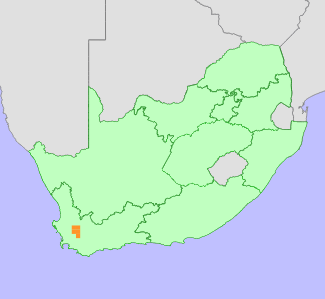|
Scientific Name | Leucadendron gydoense I.Williams |
Higher Classification | Dicotyledons |
Family | PROTEACEAE |
Common Names | Gydo Conebush (e) |
National Status |
Status and Criteria | Endangered A2a |
Assessment Date | 2020/06/09 |
Assessor(s) | A.G. Rebelo, N.A. Helme & L. von Staden |
Justification | Leucadendron gydoense has a restricted range in the mountains of the Western Cape, South Africa. It has an extent of occurrence (EOO) of 1205km² and an area of occupancy (AOO) of 96km². Subpopulations at eight to ten locations are experiencing ongoing decline in habitat quality and number of mature individuals as a result of the spread of invasive alien species. Over 50% of the former population is suspected to have been lost to the cultivation of fruit and cereals within the past three generations. It therefore qualifies for listing as Endangered under criterion A. |
Distribution |
Endemism | South African endemic |
Provincial distribution | Western Cape |
Range | This species has a limited distribution range in Koue Bokkeveld and Hex River Mountains, in the Western Cape Province of South Africa. |
Habitat and Ecology |
Major system | Terrestrial |
Major habitats | Breede Shale Fynbos, Kouebokkeveld Shale Fynbos, Western Coastal Shale Band Vegetation, Northern Inland Shale Band Vegetation |
Description | It occurs in shale fynbos at mid to high elevations. Mature individuals are killed by fires, and only seeds survive. Seeds are released after ripening, and collected by rodents and stored in underground caches, where they are protected and germinate following fires. It is dioecious, with insect-pollinated male and female flowers occurring on separate plants. Generation length is 15 to 20 years based on natural fire return intervals. |
Threats |
| A total of 24% of the habitat of this species is irreversibly modified in lowland areas of Witsenberg and Groot Winterhoek, due to historical habitat loss to cereal and fruit cultivation. These areas are suspected to have included more than 50% of the former population as this species prefers areas of extensive shale. The species now only remains on shale bands on mountain slopes, where there is continuing decline in quality of habitat due to alien invasive plants and inappropriate fire management either too- frequent or infrequent in parts of the range. Invasive aliens especially hakea are severe in the southern part of its range. |
Population |
Over 50% of the former population has been effectively eliminated from its extensive and dense low lying subpopulations, most of this loss took place within the past three generations as cultivation took place between 1960 and 1980. Currently, only remote shale band subpopulations remain, there are between 15 and 19 subpopulations at eight locations. While the majority of subpopulations are now formally protected in provincial and local nature reserves, the population is still declining due to competition with invasive species.
|
Population trend | Decreasing |
Conservation |
| Protected in the Groot Winterhoek, Koue Bokkeveld mountains, and in the Ceres Mountain Fynbos Reserve and also in the Fonteinjtiesberg Nature Reserve. Protection is however, not effective as invasive alien plants spreading rapidly within reserves. |
Assessment History |
Taxon assessed |
Status and Criteria |
Citation/Red List version | | Leucadendron gydoense I.Williams | EN A2a | Raimondo et al. (2009) | |
Bibliography |
Goldblatt, P. and Manning, J.C. 2000. Cape Plants: A conspectus of the Cape Flora of South Africa. Strelitzia 9. National Botanical Institute, Cape Town.
Manning, J.C. and Goldblatt, P. 2012. Plants of the Greater Cape Floristic Region 1: The Core Cape Flora. Strelitzia 29. South African National Biodiversity Institute, Pretoria.
Raimondo, D., von Staden, L., Foden, W., Victor, J.E., Helme, N.A., Turner, R.C., Kamundi, D.A. and Manyama, P.A. 2009. Red List of South African Plants. Strelitzia 25. South African National Biodiversity Institute, Pretoria.
Rebelo, T. 2001. Sasol Proteas: A field guide to the proteas of southern Africa. (2nd ed.). Fernwood Press, Vlaeberg, Cape Town.
|
Citation |
| Rebelo, A.G., Helme, N.A. & von Staden, L. 2020. Leucadendron gydoense I.Williams. National Assessment: Red List of South African Plants version 2024.1. Accessed on 2025/12/23 |
 Comment on this assessment
Comment on this assessment

